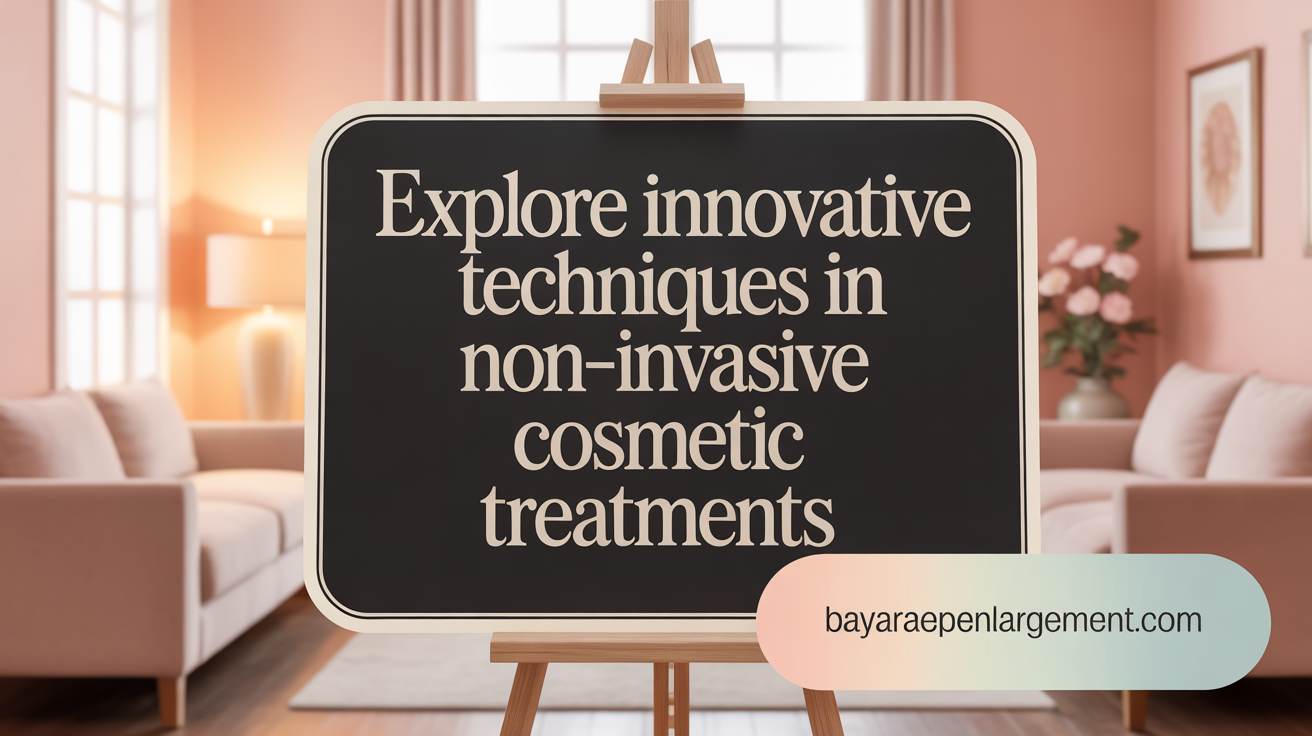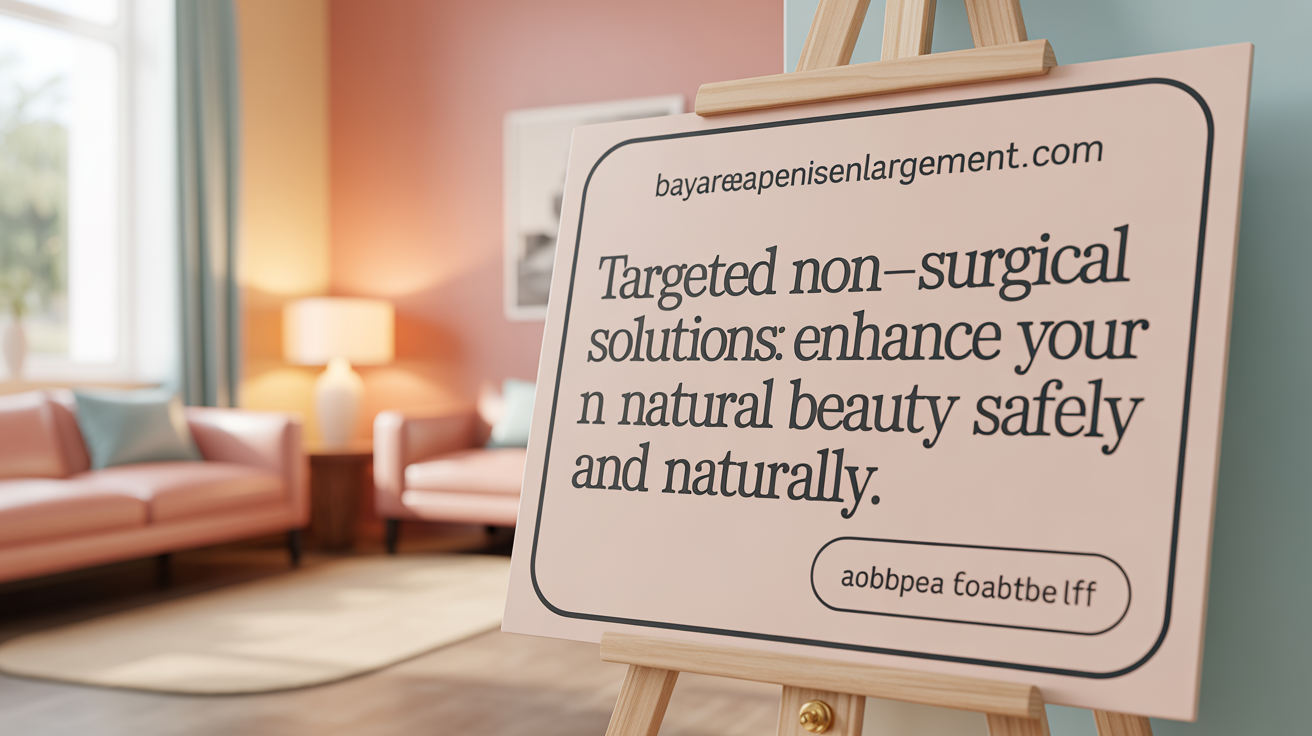Understanding Non-Surgical Options Today
Non-surgical procedures have revolutionized the realms of cosmetic enhancement and medical treatment by offering minimally invasive alternatives that avoid the risks and downtime associated with surgery. Leveraging advanced technologies and innovative techniques, these treatments deliver subtle yet effective results for facial rejuvenation, body contouring, injury recovery, and pain management. This article delves into the essential aspects of non-surgical procedures — from popular aesthetic treatments and their mechanisms, to safety considerations, candidacy, and how they compare with surgical options — providing you with a comprehensive guide to making informed decisions about your care and appearance.
An Overview of Non-Surgical Cosmetic Procedures and Technologies

What are non-surgical cosmetic procedures and what are the main types?
Non-surgical cosmetic procedures encompass treatments that improve appearance without surgical incisions or anesthesia. These minimally invasive or non-invasive methods include injectables such as Botox and dermal fillers, laser treatments for skin resurfacing and hair removal, chemical peels, microdermabrasion, and non-surgical body contouring techniques. They often utilize sophisticated medical devices that generate heat, cold, light, or sound waves to target specific skin layers or tissues.
Most of these procedures aim to rejuvenate the skin, diminish wrinkles, restore volume, or reduce fat. They generally involve less risk, shorter recovery times, and are more affordable than surgical options. Most effects are temporary, requiring regular maintenance sessions to sustain results. These treatments are suitable for a wide age range and can be performed in outpatient settings, making them a popular choice for those seeking subtle, natural-looking enhancements.
What are some popular non-surgical aesthetic treatments, and how do they work?
Popular non-surgical aesthetic methods include Botox®, which relaxes overactive facial muscles by blocking nerve signals, leading to reduced wrinkles within days and full effects in about a week. Dermal fillers like hyaluronic acid-based products provide immediate volume enhancement, smoothing out lines, and contouring facial features such as lips and cheeks. They also support collagen production over time, improving skin elasticity.
Laser treatments are used for skin resurfacing, tightening, and reducing scars by stimulating collagen production in the skin's deep layers. Radiofrequency and ultrasound treatments similarly induce collagen remodeling by heating targeted tissues, leading to firmer, more elastic skin. Non-surgical nose reshaping, known as non-surgical rhinoplasty, uses fillers to modify nose contours without traditional surgery.
Body sculpting techniques such as cryolipolysis (“CoolSculpting”) apply cold temperatures to freeze and destroy stubborn fat cells, which are then naturally eliminated by the body. These procedures work through mechanisms like muscle relaxation, tissue support, collagen stimulation, and fat cell destruction, providing effective rejuvenation with minimal downtime. Overall, they enable patients to achieve natural-looking improvements while maintaining their daily routines.
Advantages, Suitability, and Typical Outcomes of Non-Surgical Treatments

What are the benefits and advantages of non-surgical treatments compared to surgical options?
Non-surgical treatments provide several notable benefits over traditional surgery. They require little to no downtime, allowing patients to return to daily activities immediately after procedures. These treatments are often more affordable and carry fewer risks, such as scarring, infections, or longer recovery periods associated with surgery. Patients enjoy quick, natural-looking results—such as the smoothing of wrinkles or skin tightening—that can often be seen soon after treatment. Many procedures, including Botox® and dermal fillers, offer immediate or near-immediate visible improvements, with effects lasting from a few months to two years depending on the treatment. Because they are minimally invasive and outpatient-based, they are an appealing choice for those seeking subtle aesthetic enhancements without the complexity of surgery.
While surgical procedures deliver more permanent and dramatic changes, non-surgical options are ideal for individuals looking for mild to moderate improvements, especially early signs of aging. They also offer the advantage of fewer complications and less discomfort during healing, making them a popular and safe alternative for many patients.
Who is a suitable candidate for various non-surgical treatments?
Candidates for non-surgical treatments typically include adults in their 30s to 50s, or anyone with mild to moderate skin laxity and wrinkles. They are usually physically healthy, non-smokers, and interested in subtle changes rather than radical transformations. Ideal patients desire quick results with minimal discomfort and downtime, and have realistic expectations about the temporary nature of these procedures.
Individuals aiming to soften crow’s feet, smile lines, nasolabial folds or restore facial volume often find these treatments suitable. Those with significant skin sagging or deep wrinkles may need surgical options for more substantial correction. Always, a consultation with a qualified healthcare provider is important to determine eligibility based on personal health, injury history, and aesthetic goals.
What is the typical duration of results from a non-surgical facelift?
The longevity of non-surgical facelift results varies based on the specific treatments used. For example, skin tightening procedures utilizing ultrasound, radiofrequency, or laser technologies typically last between 12 to 18 months. Dermal fillers, such as hyaluronic acid-based products, generally last from six months up to two years, depending on the filler type and placement. Botox® injections usually provide results for about three to six months.
Regular maintenance treatments can help prolong effects, and combining procedures can enhance and sustain improvements. Overall, while non-surgical facelifts offer effective rejuvenation, their outcomes are temporary, requiring periodic touch-ups for continued aesthetic benefits.
| Treatment Type | Duration of Results | Typical Time to See Results | Main Purpose |
|---|---|---|---|
| Botox® | 3-4 months | Few days | Softening wrinkles |
| Dermal Fillers | 6 months - 2 years | Immediately or within days | Restoring volume, smoothing lines |
| Skin Tightening (laser, RF) | 12-18 months | Several weeks post-treatment | Lifting, skin firmness |
| Non-surgical facelift | 12-18 months | Gradually over weeks | Overall facial rejuvenation |
Understanding these timelines helps align patient expectations with achievable results, emphasizing the importance of regular maintenance to sustain a youthful appearance.
Targeted Non-Surgical Solutions for Facial Rejuvenation, Nose Reshaping, and Skin Tightening

How do non-surgical treatments for facial rejuvenation and skin improvement provide benefits?
Non-surgical options for facial rejuvenation offer numerous advantages for those seeking a more youthful appearance without the risks associated with invasive surgery. These procedures work by stimulating the body's natural collagen and elastin production, which enhances the skin's firmness, elasticity, and overall texture. Popular treatments include Botox®, dermal fillers, laser skin resurfacing, chemical peels, and microneedling.
Patients benefit from minimal discomfort, little to no downtime, and lower complication risks. These treatments can be customized to target specific areas, delivering subtle, natural results that improve over time. They also allow for regular maintenance, keeping skin looking fresh and vibrant with repeated sessions. Overall, non-surgical facial rejuvenation provides an effective, safe, and accessible way to restore a more youthful appearance without the need for extensive recovery or surgical intervention.
What non-surgical options are available for specific concerns such as nose reshaping and skin tightening?
For minor nose reshaping, non-surgical options like liquid rhinoplasty are popular. This procedure uses hyaluronic acid-based dermal fillers to alter the nose’s shape temporarily. It can smooth bumps, lift the nasal tip, or improve proportion and contour. Nose Botox can help lift and tighten the nasal muscles, reducing the appearance of drooping tips or wrinkles.
Nose thread lifts are another innovative technique, inserting biodegradable threads that lift and sculpt the nose while stimulating collagen production for longer-lasting effects. These procedures are quick, minimally invasive, and usually performed in-office with little to no downtime. Results are immediate but temporary, lasting from several months to over a year.
Skin tightening treatments use technology such as radiofrequency, ultrasound, and controlled cooling to stimulate collagen and elastin fibers. These treatments help improve skin elasticity and reduce sagging without surgery. They typically involve multiple sessions, with natural-looking results developing gradually over weeks to months, making them suitable for early signs of aging or mild skin laxity.
Safety, Risks, and Expert Guidance in Non-Surgical Procedures

What are safety considerations, risks, and potential side effects of non-surgical cosmetic procedures?
Non-surgical cosmetic procedures generally involve minimal invasiveness, but they are not without risks. Common side effects include bruising, swelling, redness, and temporary discomfort. Infections and allergic reactions are also possible if proper hygiene and materials are not used. More serious complications, although rare, can include vascular occlusion where a blood vessel is blocked, tissue necrosis, nerve damage, or even vision loss if an injection inadvertently affects the eye area. To minimize these dangers, it’s crucial that treatments are performed by qualified professionals who possess in-depth knowledge of facial anatomy and adhere to sterile protocols. Advanced techniques, such as ultrasound guidance during injections, help improve precision and safety. Patients should seek treatment only from licensed, trained practitioners to ensure procedures are carried out with appropriate skill and care, reducing the risk of adverse effects.
What factors should be considered when choosing non-surgical cosmetic treatments?
Choosing the right non-surgical treatment depends on personal goals and expectations. Patients should first identify whether they want subtle improvements or more noticeable changes, considering how each procedure aligns with their desired results. It’s important to evaluate the risks and possible side effects, as well as recovery times — some treatments may require little to no downtime, while others may need multiple sessions.
Cost and maintenance are also significant factors. Non-surgical options are usually more affordable than surgeries but often require repeat treatments to maintain results. Compatibility with lifestyle, skin type, and medical history should be discussed with a healthcare provider. Candidates should also consider their comfort level with ongoing procedures, fear of side effects, and the importance of natural versus dramatic outcomes. Clear communication with a reputable specialist helps set realistic expectations, ensuring the treatment plan matches the patient’s desires and circumstances.
By carefully considering these factors and consulting with experienced providers, individuals can choose safe, effective non-surgical treatments that enhance appearance while minimizing health risks.
Non-Surgical Medical and Sports Injury Treatments: Recovery and Pain Management
How do non-surgical medical procedures support treatment of medical injuries, sports injuries, and pain management?
Non-surgical medical procedures are essential in managing a wide range of injuries and chronic pain conditions without the need for invasive surgery. These minimally invasive techniques promote healing, reduce inflammation, and alleviate pain, often allowing patients to return to daily routines more quickly.
Orthobiologic therapies, such as platelet-rich plasma (PRP) and stem cell treatments, harness the body's natural healing abilities by injecting concentrated cellular components directly into the injured tissue. This stimulates tissue regeneration and accelerates recovery, especially for conditions like tendonitis, ligament injuries, and stress fractures.
Physical therapy complements these treatments through specialized exercises, manual therapy, and modalities like heat or cold application. This enhances circulation, increases joint mobility, and strengthens muscles, all crucial in preventing future injuries.
Injections, including corticosteroids and hyaluronic acid, provide targeted pain relief by reducing swelling and lubricating joints, making movement less painful. Imaging tools like ultrasound guide these injections precisely into the affected areas, maximizing effectiveness.
Additional therapies such as shockwave therapy break down scar tissue and promote blood flow, further supporting tissue repair. Nonsurgical treatments are especially advantageous for those seeking to avoid the risks of surgery and experience shorter recovery periods.
By combining these approaches, healthcare providers offer personalized treatment plans tailored to individual injury severity, activity levels, and overall health. These methods not only support quicker recovery but also contribute to long-term pain management and functional improvement.
Choosing Non-Surgical Options: Informed Decisions for Optimal Results
Non-surgical treatments have transformed how individuals approach cosmetic enhancement and medical care, offering safe, effective, and convenient alternatives to surgery. Understanding the variety of available procedures, their benefits, limitations, and risks empowers patients to make choices aligned with their goals and lifestyles. Consulting skilled professionals for personalized assessments ensures treatments are tailored for maximum safety and efficacy. As technology and techniques continue to evolve, non-surgical options will remain an essential part of contemporary aesthetic and therapeutic practice, enabling natural-looking improvements with minimal disruption to daily life.
References
- Non-surgical & Medical Spa Procedure Information | ABCS
- Nonsurgical Facelift: What It Is, Options & Benefits - Cleveland Clinic
- Medical procedures - non-surgical | Better Health Channel
- What Are the Pros and Cons of Non-surgical Cosmetic Treatments?
- What Is Non-Surgical Interventional Treatment? Types and Benefits
- Non-Surgical Injury Treatments | Alternatives to Surgery for Pain Relief
- Everything You Need to Know About the Non-Surgical Facelift

